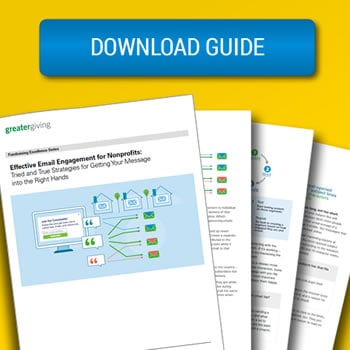
This post is the fourth in a series designed to teach the fundamentals of email marketing for nonprofits. These posts are based on the Effective Email Engagement for Nonprofits: The definitive guide to better nonprofit email marketing. Each post focuses on an element of conducting an email marketing campaign, from crafting email to measuring recipient responses and adjusting your email approach accordingly.
So you’re planning out your capital campaign—creating a schedule of which emails will go out when, and coming up with content to fill them.
This is a great time to be looking for moving stories about your work, your events, your volunteers, and your mission.
But what should be sent to the list, and when? This post will walk you through planning a capital campaign that pushes the tension ever higher, and pushes even the most reluctant supporters to jump in and donate to the cause.
1. The Opener. Once you introduce the campaign to your recipient list, clearly outline what the project is, why it’s important (how it will help the community at large), and what recipients can do to be involved.
Make sure at this stage that you introduce the stakes. That is, tell your recipients why this particular project is so critical to your nonprofit’s overall mission—and what the costs might be of not completing it in time. This is a great moment to stress why the goal amount, and the time frame, are so important to this mission.
Some general tips for capital campaign emails:
- Make links to your giving page as clear as possible.
- Include pre-determined, suggested donation amounts.
- Pepper your campaign introduction with appealing photos that harken back to your mission.
2. The Conflict. Next, it’s time to start building the tension. Write about what might stand in the way of achieving the project goal—and what the donors can do to help overcome those obstacles.
Conflicts can be small, too. Perhaps your campaign is funding a new addition to a children’s hospital, and your email is about an obstacle your team’s met in the process of getting a building permit.
Stories with a goal, an obstacle in the way of achieving it, and a heartfelt conclusion about overcoming and triumphing, appeal to the heart—and get recipients invested in your cause.
Think of your campaign like a movie, where your nonprofit work is the good guys trying to achieve something great—and various bad guys stand in the way that you need to overcome together. Stress how the money raised is helping!
3. Ramping up the action. As your campaign progresses, so should the turmoil and the obstacles. Are you going to meet the deadline? Will you raise enough money by then for the project to get off the ground? What happens if you don’t meet the goal or the time limit?
Send regular progress updates to your list as you raise money and get big donations. You might be sending emails more frequently the closer you get to your campaign deadline in order to deliver progress reports and encourage those who haven’t donated to get involved before it’s over. Remember, you can utilize Greater Giving Online Payments to help you collect and process donations online.
This is a great opportunity to do some deep dives into the purpose of the project, and what it means for your nonprofit long-term. What are you missing now that’s essential to achieving the overall mission?
Remember: return to the message and the mission, and guide your storytelling around it
4. The big twist! As you reach the final stretch of the campaign, it’s time to pull out all the stops. This is the “climax” of the story—the big moment that lies between success and failure. The tone of your emails should reflect how much closer you’re getting to the finish line with more urgency and energy.
If you’ve solicited some large donors for the campaign, this is a great time for some big contributions to come in and “save the day.” If the campaign isn’t as close to the fundraising goal as you’d originally projected, extend it, and let everyone know they still have time to contribute!
5. Resolution to the story—and the thank you. Once it’s all said and done, be sure to make an announcement about the final result of your capital campaign (whether you met the goal or not). Be sure to thank everyone who contributed!

I’m glad you pointed out in #4 that its ok to extend the fundraising goal. I have been involved with some development professionals who have no problem extending the goal when funds are short but others who look at the goal as a finish line. I think its just good business sense to allow for more time if it’s needed.
Yes, completely agree. Sometimes patience pays off. Thank you for the comment Tom!